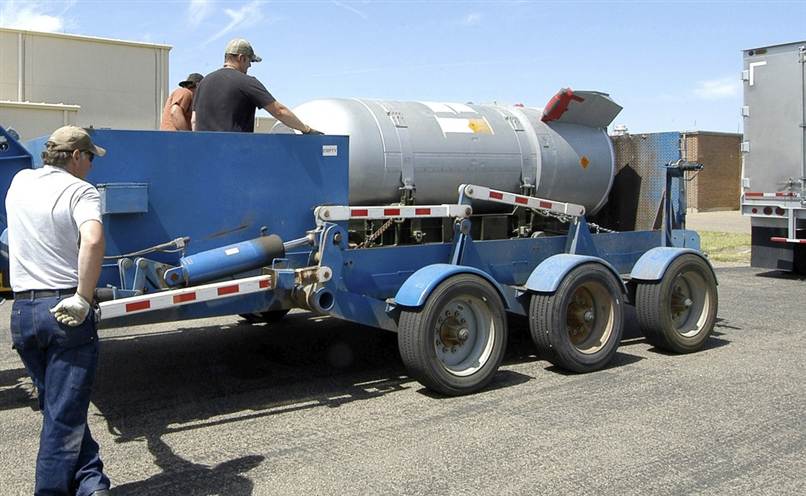MOST POWERFUL US NUCLEAR BOMB DISMANTLED

National Nuclear Security Administration via Reuters
Workers unload a B53 bomb last Feb. 14 ahead of its dismantling this week. (Yes, this is a Lift-a-Load Trailer!)
By BETSY BLANEY updated 10/25/2011 6:08:46 PM ET
AMARILLO, Texas — The last of the nation’s most powerful nuclear bombs has been taken apart in Texas.
Technicians at the Pantex Plant near Amarillo removed the uranium Tuesday from the last of the nation’s largest nuclear bombs, a Cold War relic known as the B53.
The bomb put into service in 1962 was 600 times more powerful than the atomic bomb dropped on Hiroshima, Japan, that killed as many as 140,000 people at the end of World War II.
Deputy Secretary of Energy Daniel Poneman watched workers take the bomb apart. He says it’s “a milestone accomplishment” and a step toward President Barack Obama’s mission to rid the world of nuclear weapons.
Thomas D’Agostino, the nuclear administration’s chief, called the bomb’s elimination a “significant milestone.”
Put into service in 1962, when Cold War tensions peaked during the Cuban Missile Crisis, the B53 weighed 10,000 pounds and was the size of a minivan. According to the American Federation of Scientists, it was 600 times more powerful than the atomic bomb dropped on Hiroshima, Japan, killing as many as 140,000 people and helping end World War II.
The B53 was designed to destroy facilities deep underground, and it was carried by B-52 bombers.
With its destruction, the next largest bomb in operation will be the B83, said Hans Kristensen, a spokesman for the Federation of American Scientists. It’s 1.2 megatons, while the B53 was 9 megatons.
The B53’s disassembly ends the era of big megaton bombs, he said. The bombs’ size helped compensate for their lack of accuracy. Today’s bombs are smaller but more precise, reducing the amount of collateral damage, Kristensen said.
Since the B53 was made using older technology by engineers who have since retired or died, developing a disassembly process took time. Engineers had to develop complex tools and new procedures to ensure safety.
“We knew going in that this was going to be a challenging project, and we put together an outstanding team with all of our partners to develop a way to achieve this objective safely and efficiently,” said John Woolery, the plant’s general manager.
Many of the B53s were disassembled in the 1980s, but a significant number remained in the U.S. arsenal until they were retired from the stockpile in 1997. Pantex spokesman Greg Cunningham said he couldn’t comment on how many of the bombs have been disassembled at the Texas plant.
The weapon is considered dismantled when the roughly 300 pounds of high explosives inside are separated from the special nuclear material, known as the pit. The uranium pits from bombs dismantled at Pantex will be stored on an interim basis at the plant, Cunningham said.
The non-nuclear material and components are then processed, which includes sanitizing, recycling and disposal, the National Nuclear Security Administration said last fall when it announced the Texas plant’s role in the B53 dismantling.
The plant will play a large role in similar projects as older weapons are retired from the U.S.’s nuclear arsenal.
Copyright 2011 The Associated Press. All rights reserved. This material may not be published, broadcast, rewritten or redistributed.
